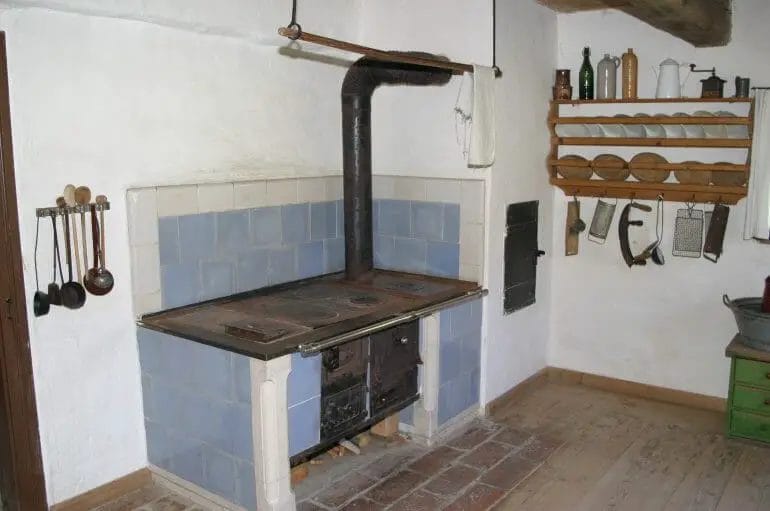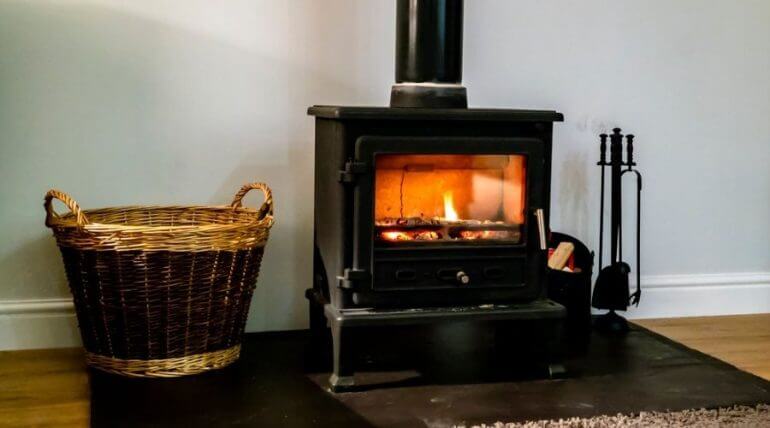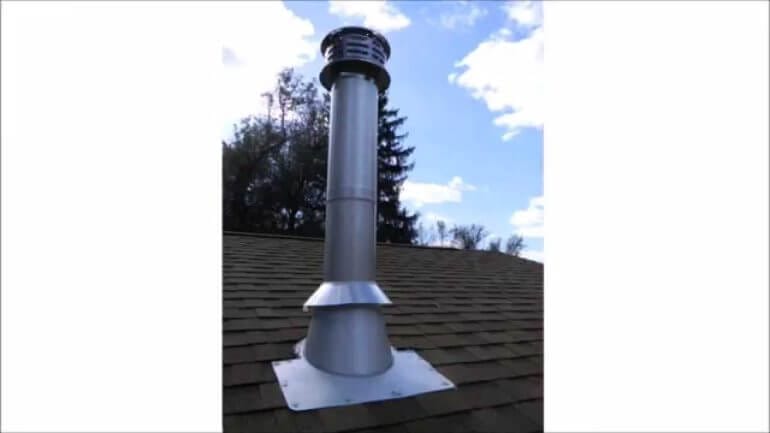When it comes to wood stove installations, the direction of the stove pipe plays a crucial role in ensuring safe and efficient operation. While it is not mandatory for a wood stove pipe to go straight up, it is highly recommended to follow certain guidelines to avoid potential issues.
A vertical installation with a straight up pipe is often the preferred choice as it helps create a strong and efficient draft, improving the stove’s performance and reducing the risk of smoke backflow. However, there are alternatives like angled or offset installations that can be used in certain circumstances.

It is important to consult local building codes and regulations and seek professional advice when planning the installation of a wood stove pipe to determine the best configuration for your specific situation. This will help ensure both safety and optimal functionality for your wood stove.

Understanding the Importance of Proper Wood Stove Pipe Placement
When it comes to installing a wood stove in your home, one crucial aspect that often gets overlooked is the proper placement of the stove pipe. The stove pipe plays a critical role in ensuring the safe and efficient operation of your wood stove. It is responsible for carrying the smoke and gases produced by the burning wood out of your home, while also providing the necessary air flow for combustion.
Proper wood stove pipe placement is essential for several reasons. First and foremost, it helps to prevent the buildup of dangerous creosote inside the pipe. Creosote is a highly flammable substance that can accumulate over time if the stove pipe is not installed correctly. This can lead to chimney fires, putting your home and loved ones at risk.
In addition to reducing the risk of chimney fires, proper wood stove pipe placement also ensures that the smoke and gases are efficiently vented out of your home. If the pipe is not installed at the correct angle or height, it can impede the natural flow of air and hinder the stove’s performance. This can result in poor combustion, reduced heat output, and even the release of harmful pollutants into your living space.
So, how do you determine the proper placement for your wood stove pipe? Here are a few key factors to consider:
1. Clearances
First and foremost, you need to ensure that your stove pipe meets the required clearances specified by the manufacturer and local building codes. Clearances refer to the minimum distance that the pipe must be kept away from combustible materials, such as walls, ceilings, and floors. These clearances are in place to prevent the risk of fire and heat damage to your home. Be sure to consult the installation manual or seek professional advice to determine the appropriate clearances for your specific wood stove.
2. Vertical Rise
The stove pipe should have a proper vertical rise to allow for efficient draft. A minimum vertical rise of 24 inches is typically recommended before any horizontal sections are installed. This helps to establish a strong draft and ensures that the smoke and gases can be effectively carried out of your home.
3. Length and Diameter
The length and diameter of the stove pipe also play a crucial role in its proper placement. The pipe should be long enough to extend beyond the roofline to prevent downdrafts and backflow of smoke. It should also have the appropriate diameter to match the requirements of your wood stove. Using the wrong diameter pipe can disrupt airflow and hinder the stove’s performance.
4. Connections
When connecting the stove pipe sections, it is important to use the correct type of connectors and follow the manufacturer’s instructions. Improper connections can lead to leaks, which not only compromise the efficiency of your wood stove but can also pose a safety hazard.
5. Professional Installation
While it is possible to install a wood stove and its pipe system on your own, it is highly recommended to seek professional installation. Professional installers have the necessary knowledge and expertise to ensure that the stove pipe is properly placed, meeting all safety and performance requirements. They will also conduct a thorough inspection to identify any potential issues and make necessary adjustments.
In summary, proper wood stove pipe placement is essential for the safe and efficient operation of your wood stove. It helps to prevent creosote buildup, ensures proper venting of smoke and gases, and maintains optimal combustion and heat output. By considering factors such as clearances, vertical rise, length, diameter, and professional installation, you can enjoy the warmth and comfort of your wood stove while keeping your home and loved ones safe.

The Benefits of a Straight-Up Wood Stove Pipe Installation
When it comes to installing a wood stove pipe, there are a few different options available. One popular choice is the straight-up installation, where the pipe goes straight up through the ceiling and roof. This method offers several benefits that make it a preferred option for many homeowners. In this section, we will explore the advantages of a straight-up wood stove pipe installation.
1. Better Draft
One of the main advantages of a straight-up wood stove pipe installation is the improved draft it provides. When the pipe goes straight up, it creates a more effective airflow, allowing the smoke and gases to be expelled more efficiently. This results in better combustion and a cleaner burn, reducing the risk of smoke entering your living space. It also helps prevent the build-up of creosote, a flammable substance that can accumulate in the chimney.
2. Increased Heating Efficiency
A straight-up wood stove pipe installation can also increase the heating efficiency of your wood stove. By having a more efficient draft, the stove can burn the wood more effectively, generating more heat and distributing it evenly throughout your home. This means that you can enjoy a warmer and cozier living space while using less wood, saving you money on fuel costs in the long run.
3. Space-Saving Design
Compared to other installation methods, a straight-up wood stove pipe installation takes up less space in your home. Since the pipe goes straight up through the ceiling and roof, it doesn’t require as much horizontal space as alternative configurations. This can be especially beneficial if you have limited space or if you want to maximize the available square footage in your room.
4. Easier Maintenance
Maintaining a wood stove pipe is essential to ensure its efficient and safe operation. With a straight-up installation, maintenance becomes easier. You can access the pipe from the ground floor or through the roof, making it simpler to clean the pipe, remove any debris, or perform regular inspections. This ease of access can save you time and make the maintenance process more convenient.
5. Aesthetically Pleasing
Lastly, a straight-up wood stove pipe installation can be visually appealing. The vertical pipe creates an elegant and streamlined look, adding a touch of rustic charm to your living space. It can be a focal point in the room, enhancing the overall aesthetics of your home. Additionally, the pipe can be customized with various finishes or decorative elements to match your interior design style.
In summary, a straight-up wood stove pipe installation offers several benefits, including better draft, increased heating efficiency, space-saving design, easier maintenance, and aesthetic appeal. Consider these advantages when choosing the best installation method for your wood stove, and enjoy the warmth and comfort it brings to your home.

Alternative Options for Wood Stove Pipe Placement
When it comes to installing a wood stove, one of the most important considerations is the placement of the stovepipe. The stovepipe plays a crucial role in directing the exhaust gases out of your home. While the traditional method involves running the stovepipe straight up through the roof, there are alternative options that you can consider. In this section, we will explore some of these alternative options for wood stove pipe placement.
1. Through the Wall
Instead of running the stovepipe through the roof, you can choose to install it through an exterior wall. This option is particularly useful if your wood stove is located on the ground floor, near an exterior wall. By running the stovepipe horizontally through the wall, you can minimize the distance the exhaust gases need to travel, improving the stove’s efficiency.
When installing the stovepipe through the wall, it is important to use proper materials to ensure a safe and efficient installation. Double-wall stovepipe, which has an inner and outer wall, is recommended to reduce the risk of overheating the surrounding walls. Additionally, you will need to install a wall thimble to provide a fire-safe passage for the stovepipe through the wall.
2. Through the Floor
If your wood stove is located on an upper level of your home, running the stovepipe through the floor can be a viable alternative. This option allows you to minimize the distance the exhaust gases need to travel vertically. By running the stovepipe through the floor, you can direct the exhaust gases to the existing chimney or vent system in the lower level of your home.
Similar to the wall installation, it is important to use double-wall stovepipe and a fire-safe floor thimble when installing the stovepipe through the floor. This will ensure proper insulation and safety.
3. Through an Existing Chimney
If you have an existing chimney in your home, you may consider using it as a venting option for your wood stove. By connecting the stovepipe to the existing chimney, you can utilize its structure to vent the exhaust gases. This option can be cost-effective, as it eliminates the need for additional piping or venting systems.
When connecting the stovepipe to an existing chimney, it is important to use a stainless steel chimney liner. This liner acts as a protective barrier, preventing the buildup of creosote and reducing the risk of chimney fires. A professional installation is recommended to ensure proper connection and safety.
4. Through an Exterior Masonry Chimney
If you do not have an existing chimney, but have an exterior masonry chimney, you can consider running the stovepipe through it. This option requires the installation of a stainless steel chimney liner, which provides a secure and efficient venting solution.
It is important to note that when using an exterior masonry chimney, you may need to install a through-wall thimble to create a fire-safe passage for the stovepipe. Additionally, proper insulation and sealing is necessary to prevent heat loss and ensure optimal performance.
Summary
While the traditional method of running the wood stovepipe through the roof is commonly used, there are alternative options for wood stove pipe placement. These include installing the stovepipe through an exterior wall, through the floor, connecting to an existing chimney, or utilizing an exterior masonry chimney. Each option has its own considerations and requirements, and it is important to ensure proper installation and safety measures are followed for efficient and effective venting.
Common Mistakes to Avoid When Installing a Wood Stove Pipe
Installing a wood stove pipe can be a cost-effective and efficient way to heat your home. However, if not done correctly, it can lead to numerous problems, including safety hazards, poor performance, and damage to your wood stove and chimney. To ensure a successful installation, it’s important to avoid common mistakes that many homeowners make. In this section, we will discuss five common mistakes to avoid when installing a wood stove pipe.
1. Incorrect Sizing
One of the most common mistakes homeowners make is choosing the wrong size of stove pipe. It’s crucial to select a pipe that matches the size and capacity of your wood stove. If the pipe is too small, it can restrict airflow and cause the stove to burn inefficiently. On the other hand, if the pipe is too large, it can lead to excessive heat loss and decreased performance. To determine the correct size, refer to the manufacturer’s guidelines or consult with a professional.
2. Poor Assembly
Proper assembly of the wood stove pipe is essential to ensure a safe and efficient operation. Many homeowners make the mistake of not properly securing the sections of the pipe or using incorrect connectors. This can result in leaks, which can lead to the release of dangerous gases, such as carbon monoxide, into your home. It’s important to follow the manufacturer’s instructions carefully and use high-quality connectors to ensure a tight and secure fit.
3. Inadequate Clearances
Another common mistake is not providing adequate clearances between the wood stove pipe and combustible materials, such as walls, ceilings, and flooring. Failure to maintain proper clearances can pose a fire hazard and increase the risk of accidents. It’s crucial to follow the building codes and regulations in your area to determine the required clearances. Additionally, consider using heat shields or insulation to further protect combustible materials.
4. Improper Placement
The placement of the wood stove pipe plays a significant role in its performance and safety. Many homeowners make the mistake of installing the pipe too close to walls or in areas with limited ventilation. This can lead to overheating, damage to the surrounding structures, and reduced efficiency. It’s important to position the pipe away from combustible materials and ensure proper ventilation to prevent overheating and enhance the draft.
5. Neglecting Regular Maintenance
Maintaining your wood stove pipe is crucial to ensure its longevity and optimal performance. Neglecting regular maintenance can lead to creosote buildup, which can clog the pipe and increase the risk of chimney fires. It’s essential to clean the pipe periodically, inspect for any damages or leaks, and remove any obstructions. Additionally, consider hiring a professional chimney sweep for a thorough cleaning and inspection at least once a year.
In summary, avoiding these common mistakes when installing a wood stove pipe is vital to ensure the safety, efficiency, and longevity of your heating system. Always follow the manufacturer’s guidelines, consult with professionals if needed, and adhere to building codes and regulations in your area. By doing so, you can enjoy the warmth and comfort of your wood stove while minimizing the risks associated with improper installation.
FAQs
Does a wood stove pipe have to go straight up?
No, a wood stove pipe doesn’t have to go straight up. It can be installed with offsets and bends as necessary to fit the layout of your home. However, it is important to consult local building codes and the manufacturer’s instructions to ensure proper installation and safety.
Conclusion
In conclusion, when it comes to the installation of a wood stove, the direction of the stove pipe plays a crucial role. While it is not mandatory for the pipe to go straight up, it is highly recommended for optimal performance and safety. A straight vertical pipe allows for better draft, efficient heat transfer, and reduces the risk of creosote buildup. However, in certain cases where a straight installation is not feasible, you can use angled sections or elbows to redirect the pipe. It is important to consult with a professional to ensure proper installation and adherence to local building codes.